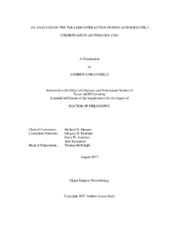| dc.description.abstract | Escherichia coli senses a variety of chemoeffectors. The Tsr chemoreceptor is known to mediate attractant response to serine. Previously, serine was the only attractant described for Tsr. Recent work suggests Tsr senses Autoinducer-2 as an attractant via a periplasmic binding protein. Autoinducer-2 is a general quorum sensing molecule recognized by Gram positive and Gram negative bacteria. In E. coli it is bound to LsrB during AI-2 uptake.
A testable model, based on the described interaction between MBP and the Tar chemoreceptor in E. coli, was generated. I first hypothesized that the shoulder regions of Tsr would associate with areas of both the amino and carboxyl domains of LsrB to elicit chemotaxis to AI-2. To test this, alanine-scanning mutations were generated in both Tsr and LsrB. Results suggest AI-2 is sensed through a direct interaction between Tsr and LsrB. I conclude residues Lys-147 and Glu-150 of Tsr and Asp-59, Asp-63 and Arg-252 of LsrB are critical for AI-2 chemotaxis.
I investigated the relationship between LsrB expression and AI-2 chemotaxis. I hypothesized altering expression of LsrB relative to chromosomal level would affect AI-2 chemotaxis. This was tested by growing cells to late phase, increasing LsrB present, and by inducing plasmid-borne LsrB. The results suggest increasing the LsrB present decreases AI-2 chemotaxis, though a clear conclusion cannot be drawn. I also explored the effect making lsr deletions would have on LsrB expression and AI-2 chemotaxis. I conclude there is little effect on AI-2 chemotaxis in these mutants. Lastly, I hypothesized serine and AI-2 affect signaling to each other. This was tested by using Tsr variants deficient for serine chemotaxis to test AI-2 chemotaxis to establish that recognition of serine and AI-2 occurs independently at separate locations on Tsr. I introduced one ligand during log phase growth and tested chemotaxis response to the other ligand. Results indicate that serine and AI-2 bind at separate sites. However, AI-2 chemotaxis decreased when serine was present, though not vice versa. I conclude the response to serine is more robust since there are a limiting number of LsrB proteins present in the cell. | en |


